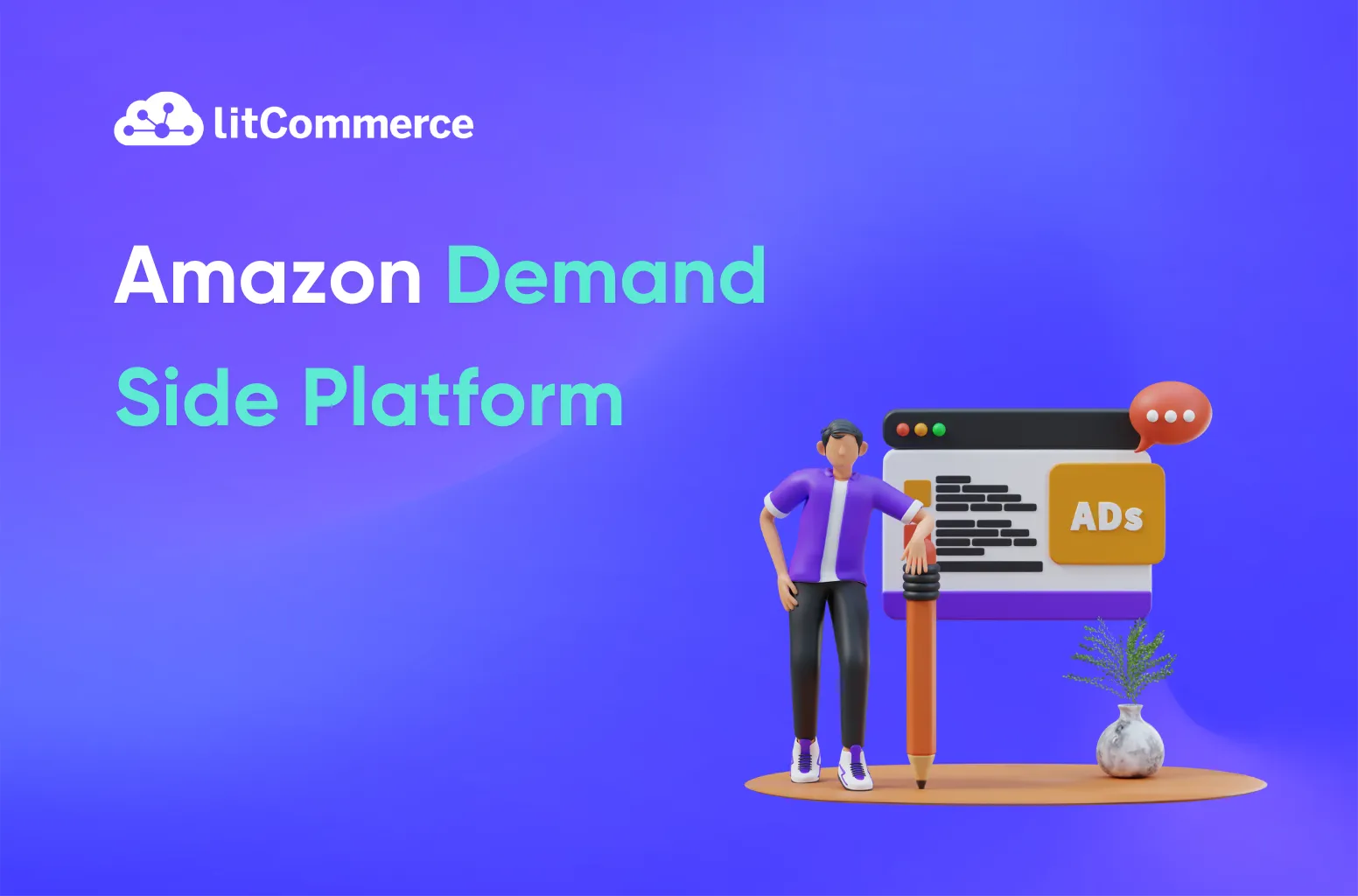Amazon Demand Side Platform (DSP) is a powerful advertising tool that enables businesses to programmatically buy ads across Amazon’s ecosystem and beyond.
Many sellers choose it to enhance brand visibility, reach targeted audiences, and drive conversions through advanced targeting options. However, understanding its features and strategies is crucial for maximizing its effectiveness.
This article will dig deeper into Amazon DSP, its key benefits, and how you can integrate it into your marketing plan.
Keep reading to explore:
- What is Amazon Demand-side Platform (DSP)?
- Who can use Amazon DSP?
- Benefits of the Amazon Demand-side Platform
- How much does the Amazon Demand-side Platform (DSP) cost?
- Integrating Amazon DSP into your marketing funnel
- Amazon Demand-side Platform: Lessons from brands
Wait no more, let’s dive right in!
What is Amazon Demand Side Platform (DSP)?
Amazon DSP is a programmatic advertising platform offered by Amazon. It allows businesses of all sizes to purchase ad placements across a vast network to reach new and existing audiences anywhere they spend their time.
Ads will appear across various Amazon-owned platforms and its third-party partner, allowing you to reach your audience through these inventory sources:
- Amazon.com (homepage, product detail pages, search results, etc.)
- Amazon-owned devices (Fire TV, Fire tablets, Kindle)
- Other Amazon-owned websites (IMDb, Amazon Publisher Direct, Audible, Twitch.tv, etc.)
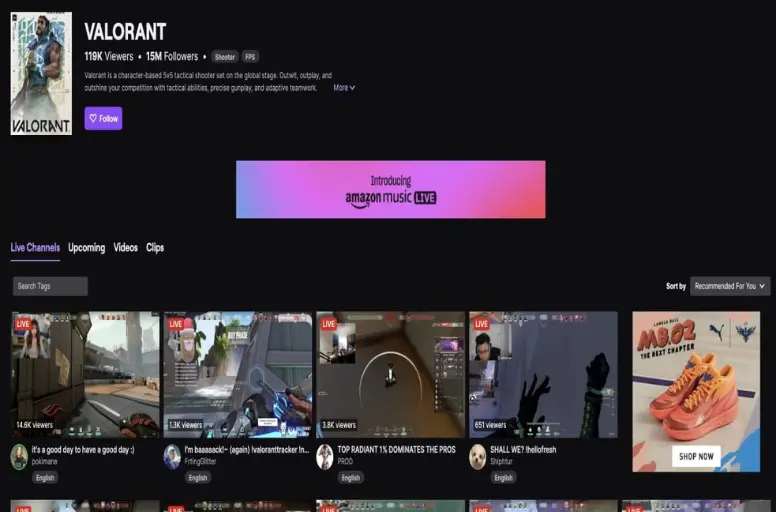
What ad types are available through DSP?
Amazon Demand Side Platform provides a range of ad types to connect with your target audience. Let’s explore what these options are and how they can help you achieve your advertising objectives.
1. Display ads
These are the most popular types on Amazon, including static or animated banner ads to promote products and brands across various platforms. These ads can appear on Amazon’s properties, such as the Amazon website, Fire TV, and Twitch, as well as on third-party websites and apps.
2. Video ads
Video ads are becoming increasingly popular due to their engaging nature. They can be in-stream (played before, during, or after video content) or out-stream (displayed on web pages outside of video players). DSPs might also support Over-the-Top (OTT) video ads for streaming services. Here are the main types of Amazon DSP video ads:
- Sponsored Display Video Ads: non-skippable, full-screen video ads shown before, during, or after streaming content on connected TVs, desktops, and mobiles.
- Online videos: in-stream and out-stream video ads on Amazon and third-party websites across all devices.
- Sponsored brand videos: autoplay video ads in Amazon search results and product detail pages.
- Sponsored display videos: autoplay video ads on Amazon’s homepage, detail pages, and various other Amazon-owned and third-party sites.
- Sponsored TV: video ads through a self-service solution on streaming TV to reach customers with content they enjoy.
- Amazon Live: live shopping experiences where influencers and experts demonstrate products.
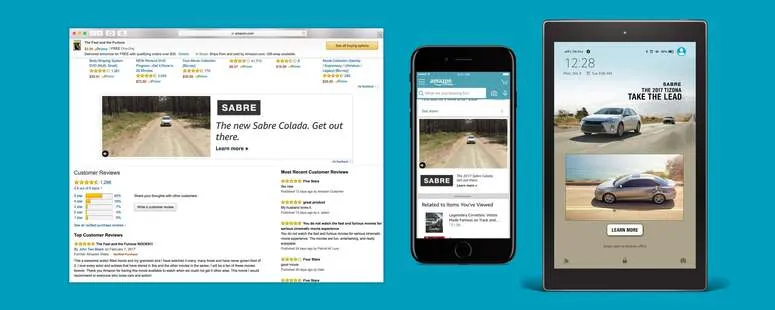
3. Audio ads
Amazon Demand Side Platform also offers audio ads, which play audio content on Amazon Music’s ad-supported tier, Alexa News, Twitch, and Amazon Publisher Direct. These ads are usually short, up to 30 seconds, non-skippable, and aim to boost brand awareness.
What is more, Amazon DSP also offers interactive audio ads. That makes it easier for listeners to engage with brands using just their voice. When listening to Amazon Music’s ad-supported tier on an Alexa-enabled device, users can respond to the ad’s call-to-action by voice to purchase without interrupting their music.

What is the difference between Amazon DSP and Sponsored Ads?
Many advertisers are confused about the differences between Amazon DSP advertising and Sponsored Display ads. Although both are Amazon-owned, they have notable distinctions. To make it easier to understand, we’ve created a comparison table for quick reference.
Feature | Amazon DSP | Sponsored Ads |
Target Audience | ‣ Sellers and non-sellers on Amazon | ‣ Only sellers on Amazon |
Placements | ‣ On and off Amazon (websites, apps) | ‣ Only on Amazon properties |
Ad Formats | ‣ Display, Video, Audio, Native | ‣ Display (Product Listing Ads) |
Targeting Options | ‣ Extensive (demographics, interests, purchase intent, etc.) | ‣ Product-based (keywords, categories, product targets) |
Bidding Model | ‣ CPM (cost-per-thousand impressions) | ‣ PPC (pay-per-click) |
Campaign Management | ‣ Self-service and Managed-service options | ‣ Self-service only |
Minimum Budget | ‣ Higher (DSP's managed-service option typically requires a minimum spend of $50,000 USD) | ‣ Lower (minimum investment is as low as $1) |
Read more: Amazon ads guide and best practices.
Who Can Use Amazon DSP?
Amazon Demand Side Platform is accessible to all advertisers, including businesses that sell on Amazon and those that do not. This means you don’t need to be an Amazon seller to use the advertising platform.
You also don’t need to be an ads expert to use Amazon DSP advertising as well. Any business can choose between self-service or managed-service options.
In the self-service model, advertisers and agencies can directly manage their campaigns without the need for insertion orders (IOs) or campaign minimums. In other words, sellers can enjoy full control over their ad campaigns and this option is good for experienced advertisers.
In contrast, the managed service option is ideal for those needing help or new to programmatic advertising. This option requires a minimum spend of $50,000 USD and includes comprehensive campaign management by experts.
Benefits of the Amazon Demand Side Platform
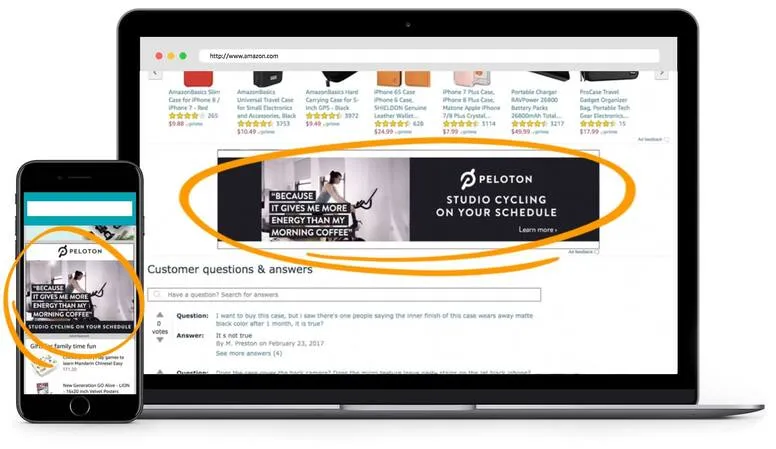
1. Raise awareness beyond Amazon shoppers
Unlike Sponsored Ads, which are restricted to the Amazon marketplace, Amazon DSP lets you target users on websites and apps across the internet. This helps you broaden your reach to potential customers who aren’t active on Amazon.
2. Target audience segments
Amazon uses its large user data to create specific audience groups. You can target users based on their demographics, interests, purchase history, online behavior, and even life stage. This helps ensure your ads are seen by people who are most likely to buy.
3. Variety of ad formats
Amazon DSP provides various ad formats, such as display ads, video ads, and audio ads. This flexibility lets you customize your message for different platforms and user preferences.
4. Get market data for your business
Amazon DSP helps you understand your audience and speak their language, leading to better results. Imagine Amazon DSP advertising as a giant toolbox filled with information about your target audience. This toolbox lets you track important details like how many people see your ads, who they are, and what actions they take. By using this information, you can get a clearer picture of who your ideal customers are. Then, you can fine-tune your marketing messages to better resonate with them, making your campaigns more effective overall.
5. Increase conversion
Amazon DSP boosts conversions by targeting potential customers at different stages of their purchasing journey with relevant, personalized ads. By delivering the right message to the right audience at the right time, sellers can drive consideration, increase purchase intent, and ultimately boost sales and conversions on the platform.
How Much Does the Amazon Demand-side Platform (DSP) Cost?
Amazon Demand Side Platform costs vary depending on the service you choose and your bidding strategy. Here are the key details:
1. Bidding strategy
The Amazon Demand Side Platform uses a cost-per-thousand-impressions (CPM) pricing model, meaning you pay a fixed rate for every thousand ad impressions. Typically, the average cost can vary from a few cents to a few dollars per thousand impressions, depending on factors like audience targeting, ad format, and competition.
There are two types of bidding auctions: first-price and second-price:
1. First-price auctions
A first-price auction is a digital buying model where the highest bidder above the floor price wins the auction (i.e. the impression), and pays exactly the amount they bid.
2. Second-price auctions
In second-price auctions, the highest bidder above the floor price wins the auction (i.e. the impression) and pays $.01 above the second-highest bid.
For example, three advertisers participate in a second-price auction for a display ad. All three advertisers put in the highest bid they are willing to pay for the ad:
- Advertiser A bids $0.75
- Advertiser B bids $1.00
- Advertiser C bids $0.50
In this case, the winning bidder bid $1.00 and paid $0.76.
2. Service options
There are two main service options:
- Self-service: This gives you full control over your campaigns but requires some knowledge of campaign management and optimization. There are no additional management fees with this option. However, basic campaigns might cost at least around $10,000 monthly. This amount can vary depending on your bidding strategy and campaign goals.
- Managed-service: Amazon offers a managed service option where experts handle campaign creation, management, and optimization. This comes at an additional cost on top of your ad spend. Specifically, sellers need to spend a minimum of $50,000 to get started.
Integrating Amazon DSP into Your Marketing Funnel
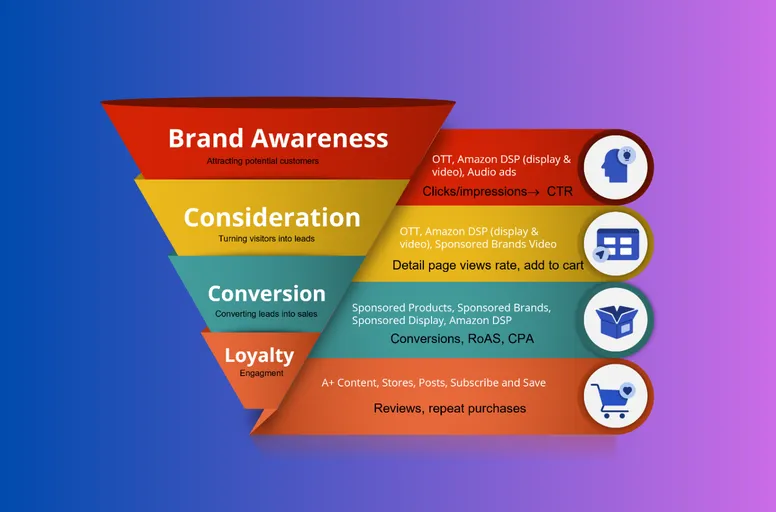
How to use Amazon Demand Side Platform effectively? Let’s see how Amazon DSP ads fit throughout the marketing funnel to learn more about the strategy you can use.
1. Awareness
You already know that its bidding model charges per 1,000 impressions. That means DSP ads were designed to help raise brand awareness and educate customers about products. To drive awareness, brands must reach consumers where they are, such as on TV, digital channels, social media, and streaming services. Hence, at this stage, running video and audio ads across platforms that target customers often visit is a great plan.
2. Consideration
Consideration marketing aims to increase consumers’ chances to choose a specific brand when shopping. At this stage, customers are getting to know the brand and what sets it apart.
Hence, at the consideration level, sellers can use video ads and display ads from Amazon DSP advertising to create touchpoints for customers who are actively researching products. Examples of marketing solutions at this stage include positive customer reviews, testimonials, and case studies. Sellers can also employ the CTA buttons to increase customers’ chances of ordering directly from the ads.
3. Conversion
The conversion stage is where potential customers decide to buy. At this phase, you can use Amazon DSP to re-engage interested users through retargeting strategies. By showing targeted ads to these users, sellers can remind them of products. You can highlight special offers and provide incentives to complete their purchases, thus increasing the likelihood of conversion and driving sales.
4. Loyalty
Some businesses may not use advertising at this stage, but if you want to nurture customer loyalty, Amazon DSP can help. For example, sellers can target previous customers with personalized ads for related products or loyalty incentives. This way helps them encourage repeat purchases and turn satisfied customers into brand promoters.
Amazon Demand-side Platform: Lessons from Brands
Now, many brands are using this Amazon DSP advertising to break free from their niche and reach a whole new audience. Below are some real case studies of seller using DSP that we think you can learn some things from them.
Learn more: Amazon advertising mistakes that anyone can read to avoid.
Case study 1: Aveeno Baby

Aveeno Baby, a trusted global brand for baby skincare, partnered with Amazon Ads to boost its presence in India. They use Amazon Demand Side Platform to develop a full-funnel strategy to enhance brand awareness, consideration, and purchase intent.
What they did:
They created a campaign targeting parents of newborns to three-year-olds through 15-second in-stream videos and static creatives on streaming sites and third-party apps.
The results:
- 110 million impressions, reaching 6 million parents in nine weeks.
- 6x increase in brand searchers and browsers,
- 22% rise in branded searches
- 11% boost in brand awareness
- 8x increase in purchase rates by using multiple DSP ad formats compared to a single ad format.
Lessons from the brands:
- Targeting the right audience
- Using a combination of video, static images, and display ads to drive conversions effectively
Case study 2: LG
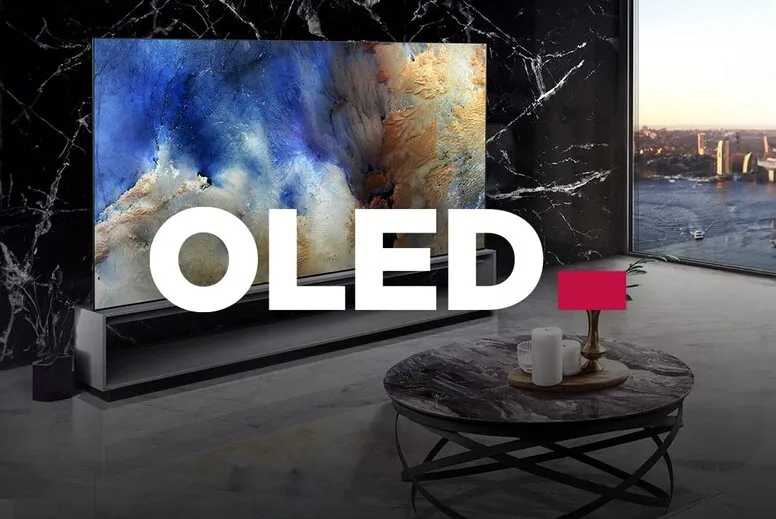
Since 2013, LG Display has supplied OLED panels to TV manufacturers, offering vivid and eco-friendly screens. To address challenges in conveying the value of OLED technology, LG Display partnered with Amazon Ads and DigitalFirst Inc. for a pre-Prime Day brand awareness campaign.
What they did:
DigitalFirst created special landing pages for LG Display, allowing flexible content structuring and full access to Amazon Ads signals. To customize messages, they segmented customers into gamers, home theater enthusiasts, and general TV buyers, resulting in high engagement. They used OTT streaming TV ads, targeting owners of TVs older than five years to boost Prime Day sales and highlight OLED benefits.
LG Display also used Amazon DSP advertising for A/B testing with insights from Amazon Marketing Cloud for customer journey and conversion analysis. This approach helped identify high-value audiences and peak conversion times, enhancing their reach with effective OTT ad campaigns.
Results:
- U.S. ad traffic increased by 38%.
- LG Display OLED brand awareness rose by 16%.
- Preferences for OLED screens increased by 11%.
- Return on ad spend during Prime Day was 5,916%.
Lessons from brands:
- Segment your audience based on interests to tailor messaging for better engagement.
- Create special landing pages to control content and campaign optimization.
- Conduct A/B testing to understand audience preferences based on region and stage in the marketing funnel.
- Utilize customer journey and conversion analysis to identify high-value audiences and optimize campaign reach.
Amazon Demand Side Platform: FAQs
DSP on Amazon is a demand-side platform that enables you to purchase ads programmatically to engage both new and existing audiences across various platforms. A demand-side platform (DSP) lets advertisers buy ad space on various websites and apps through real-time auctions. Instead of contacting each website owner individually, a DSP gives you access to a massive pool of ad inventory across the web. Here’s how it works: Yes, DSP is primarily used for top-of-funnel marketing, focusing on brand awareness and reaching potential customers early in the purchasing journey. Costs in Amazon Demand Side Platform typically include a bidding model that charges per 1,000 impressions (CPM). If you use the managed-service option, you need to spend a minimum of $50,000 to get started. The primary differences between Amazon DSP and Amazon Sponsored Ads are the accessibility and targeting capabilities.
Make Use Of Amazon Demand Side Platform Today!
While Amazon Demand Side Platform offers impressive reach across the web and within Amazon itself, it’s not a “set it and forget it” solution. To make full use of it, you should plan, monitor, and optimize your campaigns carefully. Experiment with targeting and creative approaches, and keep a close eye on performance metrics to maximize your return on ad spend.
Feel free to reach out to LitCommerce if you have any queries about selling on Amazon or any other platform. Our dedicated support team is here to assist you promptly. For regular access to millions of informative and expert-driven content, explore Blog and contact us now.

